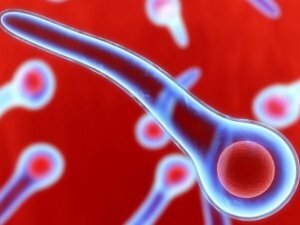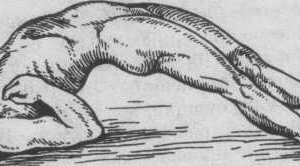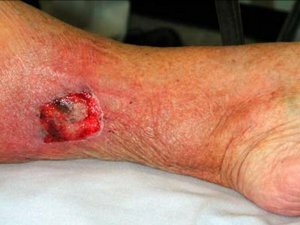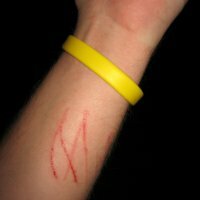Tetanus
 Tetanus is an acute infectious disease, which affects the nervous system. This disease is accompanied by spasms of skeletal musculature, possibly the development of asphyxia. Hippocrates first gave the name to this disease and described it. Next we will describe the peculiarities of this dangerous disease.
Tetanus is an acute infectious disease, which affects the nervous system. This disease is accompanied by spasms of skeletal musculature, possibly the development of asphyxia. Hippocrates first gave the name to this disease and described it. Next we will describe the peculiarities of this dangerous disease.
Etiology of the disease
It is known that the incubation period is from 1 day to 3 weeks, on average, from 7 to 14 days. Sometimes clinical manifestations are revealed after the healing of infected wounds. Doctors believe that if the incubation period of the disease is short, then the disease is more difficult to bear.
Symptoms of tetanus
 The tetanus begins acutely. The initial and often manifested symptom of tetanus is convulsive compression of the jaws( trismus), it occurs as a result of contraction of the muscles of the chewing musculature. With this symptom, there are two more signs of this disease, which form a classic triad called "sardonic smile" due to reduction of mimic muscles, dysphagia( difficulty swallowing) due to spasm of the muscles of the pharynx. Only in tetanus do the combinations of these signs appear.
The tetanus begins acutely. The initial and often manifested symptom of tetanus is convulsive compression of the jaws( trismus), it occurs as a result of contraction of the muscles of the chewing musculature. With this symptom, there are two more signs of this disease, which form a classic triad called "sardonic smile" due to reduction of mimic muscles, dysphagia( difficulty swallowing) due to spasm of the muscles of the pharynx. Only in tetanus do the combinations of these signs appear.
In an acute period of the disease, painful spasms spread to the muscles of the body and limbs, without touching the hands and feet. Hypertension of muscles occurs constantly not only during the day, but also during sleep. With the spread of convulsions in the intercostal muscles and diaphragm, breathing becomes difficult, it becomes superficial and too frequent. Because of the tone of the muscles of the perineum, urination and defecation are impaired.
As a result of the strongest tonus and painful condition of the back muscles, opisthotonus develops in severe cases of the disease. In this case, the back of the patient arches with an arch, so that between the back and the surface on which the patient is lying, one can easily thrust a hand. Spasm of the muscles is very strong and can lead to fractures of the bones, as well as muscle detachment from the bones. A convulsive contraction can occur in a short period of time or be permanent. Their origin can come from the smallest stimuli. In severe illness, seizures cause severe pain, covering a large group of muscles in the body, and proceed without interruption.
There are three degrees of severity of the disease:
- is mild;
- average severity;
- heavy form.
Diagnosis of tetanus
The diagnosis is based on the characteristic symptoms of tetanus. At the same time, laboratory diagnostics are not very important, because even the most modern methods are not able to detect toxin in the blood with clinical symptoms of the disease.
To detect tetanus at an early stage, a thorough epidemiological set of medical information is made( infected wounds, burns and frostbitten skin lesions, injuries with skin damage, obtained at the time that correspond to the incubation period) and compare them to the symptoms of the onset of the disease.
Treatment of tetanus
 Treatment takes place in the hospital, in intensive care and in the intensive care unit with the assistance of an anesthesiologist. It is also necessary to give the patient complete peace, exclude irritants( auditory, tactile and visual).Feed patients with a probe or parenterally( with weakening of the muscles of the digestive tract).
Treatment takes place in the hospital, in intensive care and in the intensive care unit with the assistance of an anesthesiologist. It is also necessary to give the patient complete peace, exclude irritants( auditory, tactile and visual).Feed patients with a probe or parenterally( with weakening of the muscles of the digestive tract).
Also conduct preventive measures of bedsores, they include turning the patient, smoothing clothes and clothes, changing and cleaning the laundry. An infected wound, even if it healed, is treated with serum against tetanus( dose-1000-3000 MI), then a thorough examination of the wound is performed and surgical treatment of the wound is carried out using wide lamp-like incisions( in order to create aerobic conditions), as well as removal of foreignBodies, clogged and dead tissue. For the prevention of seizures, these activities are conducted under anesthesia. In the future, for the treatment of wounds it is necessary to use enzymes of the proteolytic group( trypsin, chymotrypsin).
To neutralize tetanus exotoxin in the bloodstream, one-time intramuscular antitetanus serum at a dose of 50000 MI or a specific immunoglobulin at a dose of 1500-10000Ee( with an average dose of 3000Eh) must be injected, and a sensitivity test should be performed on these drugs.
These drugs should be used at the earliest possible date, because tetanus toxin unhindered circulates in the blood for no longer than 2-3 days, and the combined toxin is not inactivated, thereby reducing the effect of treatment. After receiving heterogeneous tetanus toxoid, patients should be monitored for 1 hour, as anaphylactic shock may develop.
For exclusion of a convulsive syndrome, sedatives, narcotic drugs, neuroplegic and myorelaxing drugs are used. A commonly used drug such as diazepam is used. Doses: internally 5-10 mg every 2-4 hours;In severe cases, use intravenously every 3 hours for 10-20 mg. Children are administered intramuscularly or intravenously in doses every six hours to 0, 1-0, 3 mg / kg, not exceeding ten to fifteen mg / kg per day.
It is also allowed to use injections with the composition: 2, 5% aminazine( solution), solutions of 2 mg 1% promedrola and 1% diphenhydramine, with an additional 0.05% scopolamine hydrobromide at 0. 5 ml. And additionally prescribed drugs such as barbiturates, seduxen, sodium oxybutyrate, in severe course of the disease prescribe droperidol, phenatil, curare like muscle relaxants, such as pancuronium, d -tubakurarin. With instability of the sympathetic nervous system, α -blockers and β -blockers are prescribed. When breathing is abused, a tracheotomy or intubation is used, myorelaxing drugs are used in combination with ventilation, with the release of the respiratory tract aspirator;Patients are given moistened oxygen. There is evidence that hyperbaric oxygenation can be effective.
Patients are also given laxatives, use a gas outlet tube and put a catheter in the bladder, if necessary. To avoid the formation of pneumonia, it is necessary to turn the patient over as often as possible.
Antibiotics, such as benzylpenicillin at a dose of 2 million ED, are administered intravenously( every 6 hours), tetracycline four times a day for 500 mg( children not more than thirty to forty mg / kg / day) to prevent recurrence of tetanus and treatment of bacterial complications).
When using antibiotics, there is a risk of developing pneumonia, as well as other secondary infections. For the prevention of hyperthermia, acidosis and dehydration of the body, intravenous injections of solutions of sodium bicorbinate 4%, polyionic solutions, rheopolyglucin, haemodesum and albumin and plasma are used.



